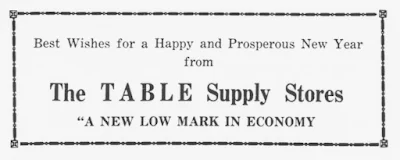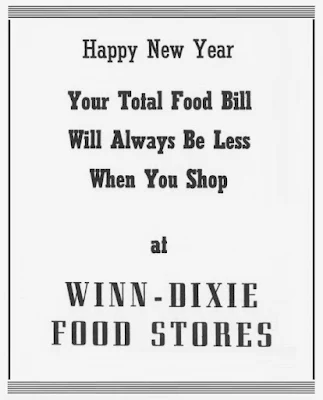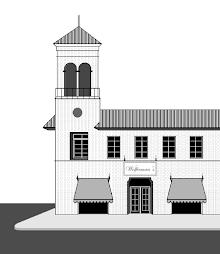Photo from www.floridamemory.com (State Library and Archives of Florida)
By late 2006 Winn-Dixie's trade area had been reduced to the states of Alabama, Florida, Georgia, Louisiana and Mississippi. On March 9, 2012, the company was acquired by Jacksonville's Bi-Lo Holdings. Bi-Lo changed its name to Southeastern Grocers in 2015. Southeastern endured a Chapter 11 Bankruptcy between March and May 2018. Ninety-eight Winn-Dixie units were shuttered. As of mid-2023, there were 542 operational stores.
In 1927, the business was renamed The Table Supply Stores. Three more Miami units were built, with a Fort Lauderdale store dedicated in 1929. The chain prospered in spite of the Great Depression, with the business expanded outside South Florida. In 1931, Tampa's Lively Stores was acquired. Orlando's B & B Stores was obtained in 1932. By 1939, The Table Supply Stores consisted of forty-three locations. A circa-1939 newspaper ad -seen above- expresses a yuletide greeting from the Davis family.
Advert from The Table Supply Stores
The second grocery chain that Winn-Dixie evolved from had been established in 1920. William R. Lovett and business partner E.L. Winn acquired Jacksonville's Tyler Grocery Company. They renamed the endeavor the Winn & Lovett Grocery Company. Lovett eventually bought Winn's interest. By 1939, he was overseeing seventy-three supermarkets and grocery stores in Greater Jacksonville.
Photo from www.floridamemory.com (State Library and Archives of Florida) / Spottswood Studio
A product display inside the Lovett's store seen above. In 1939, the Davis Brothers, now operating as the Economy Wholesale Grocery Company, acquired a 51% share of Winn & Lovett. On November 25, 1944, they obtained the remainder of the business and merged the two companies under the Winn & Lovett Grocery Company name. A corporate headquarters was established in Jacksonville.
Photo from www.floridamemory.com (State Library and Archives of Florida) / Spottswood Studio
Four Winn & Lovett groups were created after the merger. The Jacksonville Division consisted of seventy stores; these under the Table Supply Company (seen above), Lovett's and Piggly Wiggly nameplates. The Miami Division had twenty-four stores, operating as either Table Supply Company. Lovett's or Economy Wholesale Grocery. The Louisville Division was in charge of thirty stores, all bearing the Steiden Stores brand. Lastly, the Tampa Division was overseeing twenty-two Table Supply Company and Lovett's locations.
Photo from Winn & Lovett Grocery Company Annual Report 1948
Steiden Stores -of Louisville- had been acquired on July 1, 1945. By 1947, Winn & Lovett would be managing 146 stores in Florida, Georgia, Kentucky and Indiana. Margaret Ann New Era Markets {Miami and Tampa} was obtained on December 12, 1949. By 1950, the Winn & Lovett store count had reached 179. In 1952, the company became the first Florida business to be listed on the New York Stock Exchange.
Photo from Winn & Lovett Grocery Company Annual Report 1948
One of -if not- the first Kwik Chek Food Stores opened -in Clearwater, Florida- in September 1952. Apparently, no pre-history of this chain exists before the first mention of it in the Winn & Lovett Grocery Company Annual Report for 1952. It would appear that Kwik Chek was not an acquisition, but a newly-created chain of stores.
Photo from Tampa-Hillsborough County Public Library System / Burgert Brothers
An ultra-modern Kwik Chek opened, at Montgomery, Alabama's NORMANDALE SHOPPING CITY, in September 1954. The store encompassed 18,000 square feet. Another shopping center location was dedicated at Huntsville, Alabama's PARKWAY (CITY) CENTER in March 1957. This store covered 17,000.
Drawing from Winn & Lovett Grocery Company Annual Report 1953
The third major business involved in the formation of Winn-Dixie was known as Dixie Home Stores. This chain was formed, in March 1937, by the merger of two companies. Dixie Stores, of Greenville, South Carolina, opened its first unit in 1927, with Columbia, South Carolina's Home Stores starting out in 1930. Dixie Home Stores was operating 117 units in Georgia, North Carolina and South Carolina when they merged with the Winn & Lovett Grocery Company, in August 1956.
Graphic from Dixie Home Stores
Following the Winn & Lovett and Dixie Home Stores merger, the vast supermarket enterprise was re-incorporated as Winn-Dixie Stores. It operated 462 retail supermarkets, all managed from the former Winn & Lovett Jacksonville home office. The newspaper ad above, from early 1956, extends good wishes for a happy new year. At this time, the newly-formed Winn-Dixie did not have a trademark or logo.
Advert from Winn-Dixie Stores, Incorporated
The iconic check mark logo was introduced in 1958. Between 1954 and 1956, the following companies had been obtained; Jitney Jungle {Mississippi}, Hill Stores {Louisiana}, Penney Stores {Mississippi}, Ballentine Stores and Eden Stores {South Carolina}, Ketner-Milner Stores {North Carolina}, H.G. Hill Stores {Louisiana and Mississippi} and King Stores {Georgia}.
Graphic from Winn-Dixie Stores, Incorporated
A shiny new Winn-Dixie opens, at Tallahassee's PARKWAY CENTER, in June 1958. The store extended for 15,100 square feet. The company was now in charge of 495 stores. These operated in Alabama, Florida, Georgia, Indiana, Kentucky, Louisiana, Mississippi, North Carolina South Carolina, Tennessee and Virginia,
Photo from www.floridamemory.com (State Library and Archives of Florida)
We peer into the PARKWAY CENTER store in the early Sixties. The 1962 supermarket count stood at 609 Winn-Dixie and Kwik Chek units, which were operating in eleven states. By decade's end, there were 794 supermarkets. These operated under four divisions: Jacksonville {Georgia and North Florida}, Tampa {Central Florida}, Miami {South Florida} and Greenville {Georgia, North Carolina, South Carolina and Tennessee}.
Photo from www.floridamemory.com (State Library and Archives of Florida) / Richard Parks
Between the mid-1950s and mid-1960s, Winn-Dixie was the most profitable grocery chain in the South. The enterprise grew at such a prodigious rate that -in 1966- the Federal Trade Commission placed a ban on any further grocery company acquisitions. This was in force until 1972, which is also the date of the candy department snapshot seen above.
Photo from www.floridamemory.com (State Library and Archives of Florida)
In the meantime, and via a technical loophole, Winn-Dixie Stores had obtained a grocery chain in the Bahamas in 1967. In 1976, the Kimbal, Incorporated (Buddies) chain {Fort Worth} was purchased. By year's end, Winn-Dixie was operating 1,156 stores. The store count for 1980 registered 1,192 supermarkets in thirteen states. By 1985, there were 1,262 stores, with these units averaging 26,500 square feet. A new Winn-Dixie logo was introduced in the same year.
Logo from Winn-Dixie Stores, Incorporated
A new store format had been introduced in Valdosta, Georgia in 1983. The Winn-Dixie Marketplace & Food Pavilion averaged 45,000 square feet and included an eclectic collection of departments. Among these were Prestige Meat Shoppes, Fisherman's Wharf seafood, World of Cheese, Harvest Fresh produce, plus a delicatessen, bakery, pharmacy, photo lab and floral shop.
Photo from Winn-Dixie Stores, Incorporated Annual Report 1992
The chain endured heavy competition from Publix, WalMart and Food Lion during the 1980s and 1990s. Its most recent corporate acquisition -in 1995- added Cincinnati's Thriftway Food & Drug. Winn-Dixie was in charge of 1,175 stores. By the time of the circa-2006 trademark (seen above), the company was in serious financial trouble. It went through a Chapter 11 Bankruptcy between February 2005 and November 2006. 685 stores were shuttered between April 2000 and March 2006.
Graphic from Winn-Dixie Stores, Incorporated
Photo from https://www.supermarketnews.com
WINN-DIXIE JUNIOR-ANCHORED SHOPPING MALLS:
*RICHLAND MALL, Forest Acres, SC (1961)
*BREVARD MALL, Melbourne, FL (1963)
*BUFORD-CLAIRMONT MALL, Dekalb County, GA (1970)




















